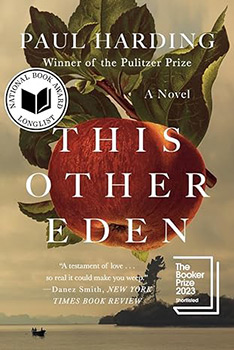Book Club Discussion Questions
In a book club? Subscribe to our Book Club Newsletter and get our best book club books of 2025!
For supplemental discussion material see our Beyond the Book article, The Malaga Island Eviction of 1912 and our BookBrowse Review of This Other Eden.
Please be aware that this discussion guide will contain spoilers!
-
A major theme of Paul Harding's This Other Eden is kinship—honored, chosen, enforced, cherished, perverted, and otherwise. How do the dynamics of kinship change throughout the novel and what does kinship mean for Harding's characters?
-
Rather than beginning the novel with the current generation of Honeys, Esther and Eha, Harding opens with the story of their ancestors, Irish-born Patience and formerly enslaved Benjamin, who first arrived on the island more than a century earlier. How does Harding weave together the different generations and storylines to explore the interconnectedness of his characters, past and present?
-
Consider this interconnectedness across generations. What might Harding be saying about belonging and identity in relation to family, history, and storytelling?
-
Matthew Diamond is a pivotal figure in the novel. When we are first introduced to him, he reveals that he feels an "involuntary repulsion whenever [he is] in the presence of a living Negro" (p. 45). How does Matthew Diamond embody and enact various aspects of white supremacy and white guilt? Reflect on specific instances when Diamond's actions or thoughts perpetuate racial discrimination and racialized power dynamics. Discuss ways in which Matthew Diamond dramatizes white guilt. How do his initial beliefs and attitudes reflect the racial ideologies of the time? How might they reflect racism in our present time? As the story progresses, how do Diamond's perceptions change? Consider that Diamond knows that he has racist sentiments and that those sentiments are deplorable, and yet still voices them.
-
The characters' interactions and perceptions portray race as a socially and culturally constructed narrative. The prejudices, stereotypes, and discriminatory behaviors depicted in the story are based on historical narratives that accord the authority, status, and appearance of scientific fact to vulgar bigotry. Discuss how race is navigated, explored, and conceived throughout the novel.
-
How does Harding depict the vulnerabilities of religion and science and cast them as instruments of self-interest and abuse? In which ways do characters like Matthew Diamond and the scientists and doctors who trespass on the island epitomize such abuses?
-
Throughout the text, religious allusions abound, such as a local hurricane being likened to the story of Noah's ark, Patience envisioning the story of Moses and the splitting of the sea during the hurricane, the names given to characters like Theophilus and Zachary Hand to God, and the title This Other Eden. Delve into these religious references and contemplate Harding's different uses of them. Consider the juxtaposition of religion as both a justification for violence and as a source of grace.
-
Theophilus and his wife, Candace, swap "traditional" gender roles. Similarly, the McDermott sisters, Iris and Violet, defy gendered expectations. Discuss the qualities of their self-determination within the context of the novel's setting and time period, within the context of our own time, and in consideration of the isolated nature of the island.
-
How do the experiences of birth and death intertwine throughout the novel? Death is not only the passing of individuals in a generation but also an avenue for escape and a means of punishment. What is Harding saying about mortality—the span of individual lives, of generations of families, of communities?
-
Consider the title of the novel, This Other Eden. It is a phrase taken from Shakespeare's play, Richard II, wherein a character laments the loss of England—"this other Eden"—to the schemes of people intent on hoarding power and wealth. Think of the narrative of Eden as it is featured in the book of Genesis. How does this novel resonate with Christian notions of paradise?
Unless otherwise stated, this discussion guide is reprinted with the permission of W.W. Norton & Company.
Any page references refer to a USA edition of the book, usually the trade paperback version, and may vary in other editions.
